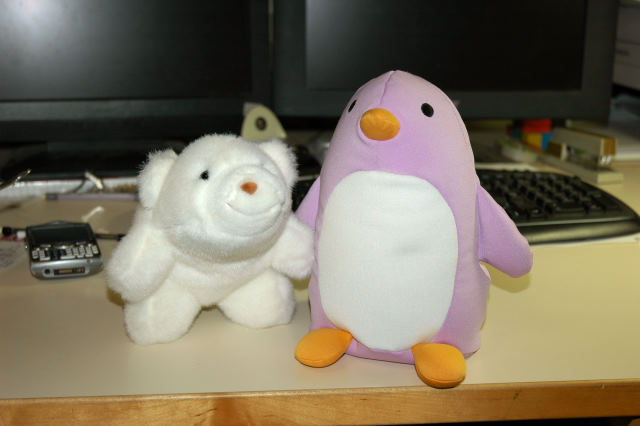Final Project Proposal: Alex Li, Julie Tung
Project Goals
We would like to realistically render two stuffed animals, a penguin and a miniature polar bear. The exterior of the penguin is polyester cloth, while the polar bear’s is of short fur. Ideally, we want to place these two animals in an interesting environment; for instance, the Arctic where they could be sitting on a bed of snow and ice.


Techniques
Fur
The polar bear’s fur will be modeled as geometry, with each hair primitive modeled as a three-dimensional Catmull-Rom spline. We will use a cylinder-based shading model in order to produce realistic shading in the fur. We would also like to create an accurate self-shadowing effect among the hairs in the fur, for which one possible technique is deep shadow maps.
Additional Sources:
Rendering Hair: http://www.rhythm.com/~ivan/hairRender.html
James T. Kajiya, Timothy L. Kay. Rendering Fur with Three Dimensional Textures. In SIGGRAPH 89
Tom Lokovic, Eric Veach. Deep Shadow Maps. In SIGGRAPH 00, July 2000.
Subsurface Scattering
We will use subsurface scattering techniques in order to make the snow look realistically translucent. Quite a bit of work has already been done in this area, both in a previous CS348B project and in subsurface scattering work in general, as snow is a relatively popular medium for the technique. We will most likely be using the techniques from this paper: http://graphics.ucsd.edu/%7Ehenrik/papers/fast_bssrdf/.
Additional Sources:
A Modeling and Rendering Method for Snow by Using Metaballs http://www.blackwell-synergy.com/doi/pdf/10.1111/1467-8659.00173
Computer modelling of fallen snow, Fearing, SIGGRAPH 2000
Optical Properties of Snow: http://www.icess.ucsb.edu/hydro/aviris/optics.html
Microgeometry of Cloth
If we have time, we would also like to accurately model the exterior of the penguin. Instead of using textures, we could model the microgeometry of the weaving of the fibers making up the penguin’s cloth.
Additional Sources:
An Approach to Cloth Synthesis and Visualization: http://www.cs.brown.edu/people/koa/cloth.pdf
Visualization of Woven Cloth: http://www2.miralab.unige.ch/papers/169.pdf
Basic Approach
Since we have several different advanced features that we would like to tackle in this project, our approach will be to prioritize and finish the two major ones (realistic fur and snow) before moving on to the others, such as the microgeometry of the cloth. For the lighting in our scene, we will most likely be using an environment map acting as an infinite area light, unless we have time to do something more elaborate.